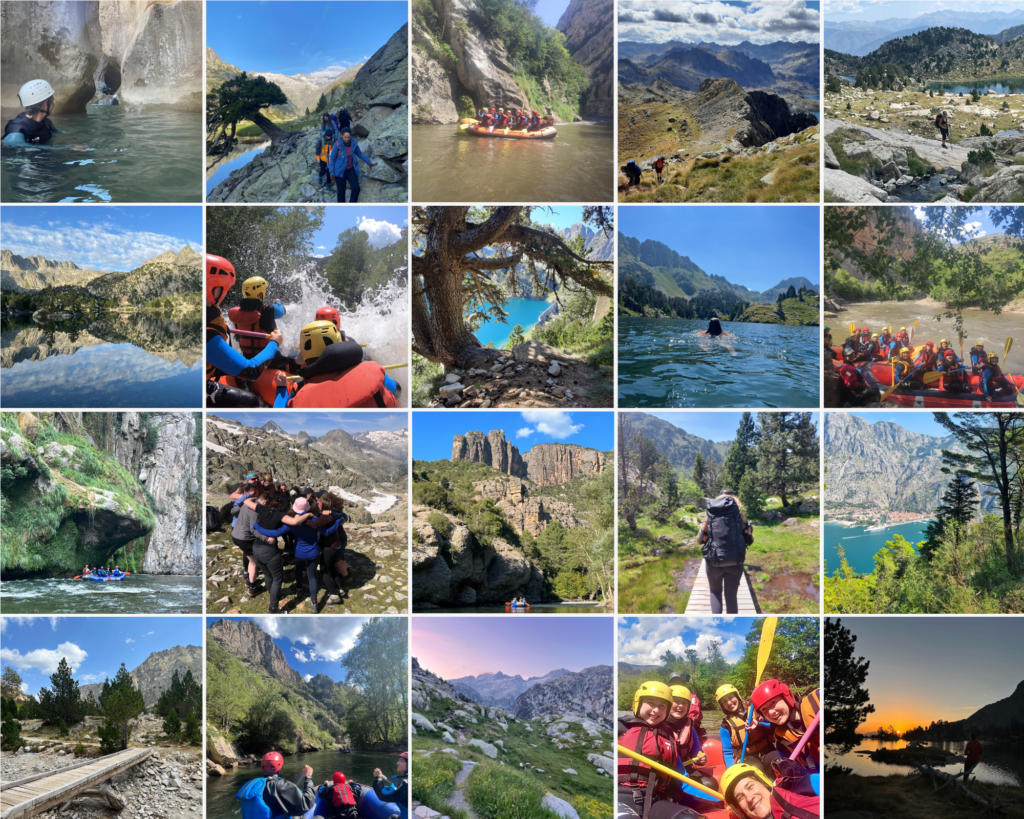The Pyrenees is a breathtakingly beautiful, wonderfully wild and entirely unforgettable mountain environment and the setting for many of our greatest adventures. Stretching the length of the French-Spanish border and home to a spectacularly diverse array of landscapes, these mountains provide some of the best hiking in Europe.
While the Pyrenees’ towering peaks, rugged ridge lines and awe-inspiring canyons ensure hiking is physically demanding, there is so much more to the region than tough climbs. From the 8th Century Battle of Roncevaux Pass to the Republican exodus at the end of the Spanish Civil War, the area is soaked in fascinating history. Myth and legend abound, while several unique cultures and languages, including Basque, Catalan and Occitan, continue to flourish.
When it comes to outdoor pursuits, the Pyrenees are second to none. From white water rafting to rock climbing, you can participate in almost any activity that piques your interest. The mountain range is home to many of the Tour de France’s most iconic climbs, some of the best mountain biking in the world and an array of first-class ski resorts.
In other words, the Pyrenees is one of the most exciting, dramatic and alluring mountain ranges in the world.
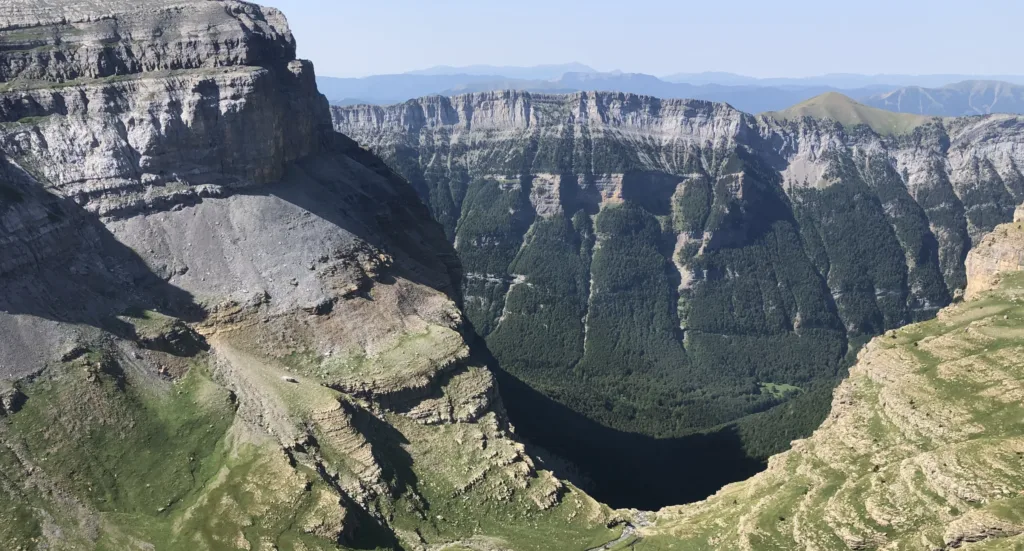
Exploring the Pyrenees
Running approximately 500 km along the French-Spanish border, from the Basque Mountains and the Bay of Biscay to the Mediterranean, the Pyrenees form a natural barrier between the Iberian peninsula and the rest of continental Europe. Aneto, the range’s tallest peak, reaches 3,404 metres and occupies a central location, close to the Andorran border.
Usually divided into three physiographic regions, the Western Pyrenees, Central Pyrenees and the Eastern Pyrenees, the mountains are older than the Alps and distinct in several ways. The lack of accessible passes and their high elevation make the mountains much more challenging to cross, while large, free-falling waterfalls dot the landscape. The range is also famous for its cirques, a geological formation where the top of valleys end in a steep, bowl-like semicircle with steep cliff sides.
What makes the Pyrenees so special?
Ask fifty seasoned Pyrenean hikers what makes the Pyrenees special, and you will likely receive fifty different answers. Some will talk about the remarkable natural beauty – the sparkle of Edelweiss growing on the flanks of the Ordesa Valley, the amphitheatre-esque natural grandeur of the Cirque de Gavarnie, the perfect stillness of the lakes in Aigüestortes I Estany of Saint Maurici National Park. Others will cite the abundance of mountain refuges, the excellent, stomach and soul-warming cuisine or the relatively empty trekking trails.
While the Alps get a lot of the glory and may attract a more glamorous, jet-set type of traveller, the Pyrenees are raw, unadulterated mountain goodness. They are unpretentious, often overlooked and underappreciated, but undoubtedly able to go toe-to-toe with any other mountain range in Europe.
A few Pyrenean highlights
When it comes to hiking highlights, the Pyrenees boasts more than its fair share. And they are spread right across the entire range, ensuring you have the opportunity to experience a few, no matter where you visit.
- Monte Perdido – Aneto may be the Pyrenees’ tallest peak, but Monte Perdido is one of its most spectacular. Located in the gorgeous Ordesa y Monte Perdido National Park, this iconic mountain is the jewel in the park’s already glistening crown.
- Circ de Colomers – Situated on the southern slopes of the Val d’Aran, the Circ de Colomers is home to some of the best hikes in the Pyrenees, as well as picturesque lakes and rocky ridgeline walks.
- Cirque de Gavarnie – Close to Monte Perdido and the Ordesa National Park, the Cirque de Gavarnie is one of the Pyrenees’ most recognisable natural highlights and is a popular destination for hikers of all abilities. The impressive Grande Cascade de Gavarnie – the highest waterfall in mainland France – is unmissable.
- Cadí-Moixeró Natural Park – Part of the Catalan Pyrenees, this idyllic area spans more than 40,000 hectares and is home to some of the Pyrenees’ lesser-known highlights, including the incredible twin-peaked Pedraforca and the delightful Serra del Cadí.
- Medieval towns and villages – Due to the challenging nature of the terrain and the relative isolation that encourages, many Pyrenean settlements have remained largely unchanged for centuries. This means there is an abundance of dazzling mediaeval towns and villages to visit. From Boí and La Roca in Catalonia to Aínsa and Benasque in Aragon, they are always a good excuse to stop for an ice-cold refreshment and a bite to eat.
- Sensational wildlife – The Pyrenees is an absolute delight for wildlife lovers. From the slow, graceful arcs of vultures flying overhead to marmots darting between rocks and proud ibex perched on mountain ridges, there is so much to see. And the quiet, traffic-free trails mean these memorable animal encounters are much more frequent than in other, busier ranges.
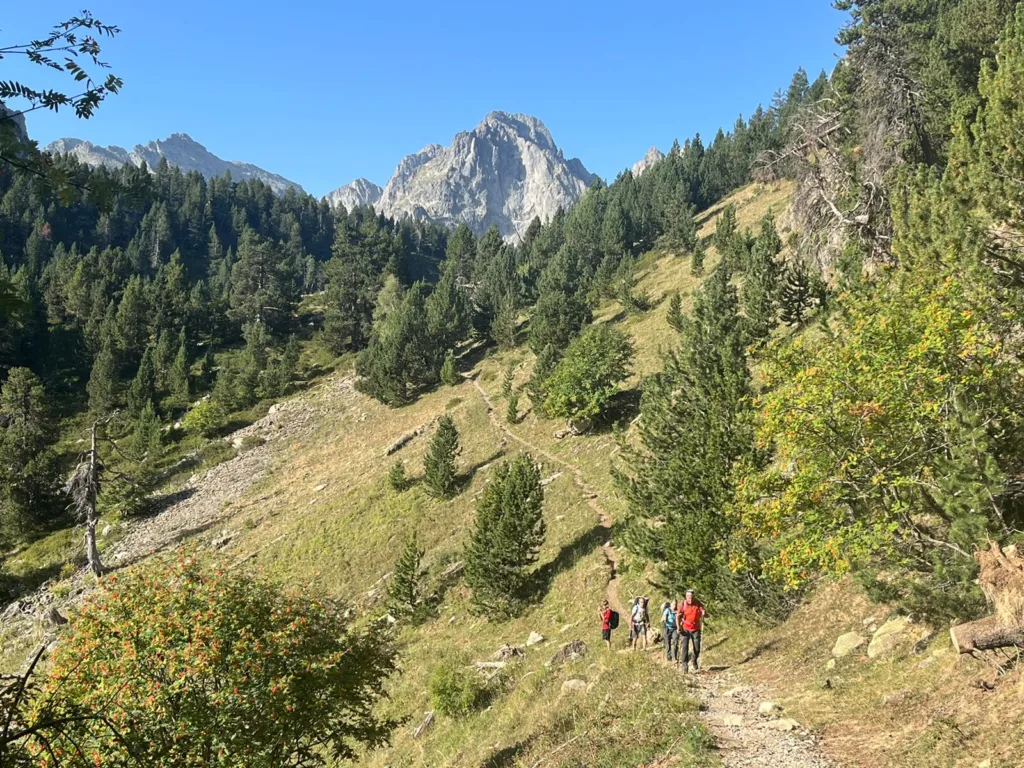
Five hikes in the Pyrenees
Picking our five favourite hikes in the Pyrenees is tricky. However, we’ve given it our best shot and come up with the following candidates.
- The Thousand Lakes
If we had to recommend a hiking route to someone who has never visited the Pyrenees before, we would probably go for the Thousand Lakes route. Typically tackled over four days, the Thousand Lakes hike weaves through the Parc National d’Aigüestortes i Sant Maurici in Catalonia. It takes you past alpine streams, deep canyons, ice-cold lakes, elegant waterfalls and some of the region’s highest peaks.
Usually, the hike begins in the Val d’Aran, joins the Pyrenean Haute Route for a stretch and takes you to the unforgettable Cirque de Colomers. It continues to Pico Montardo, where you enjoy commanding views of Aneto and the surrounding area, before finishing with the Col de Caldes and the Cirque de Travessani.
The Thousand Lakes is the ultimate Pyrenean hiking experience and cannot be surpassed when it comes to the variety of landscapes you pass through and sheer natural splendour. If you want to understand why people fall head over heels for the Pyrenees, this is the trek for you.
- Ordesa & Gavarnie
Spain’s oldest national park and home to Monte Perdido, Ordesa y Monte Perdido National Park is a Pyrenean paradise. Containing something for every type of hiker, Ordesa lets you explore exposed ridgelines where scrambling skills are essential, as well as relaxed valley trails that are suitable for all the family.
For hikers looking for a multi-day route, the Ordesa & Gavarnie Trek is unbeatable. A five-day hike that takes in the park’s highlights while avoiding busier trails and exploring its lesser-known corners, this trek exposes you to high mountain forests, alpine meadows, snow-fed lakes and rock-strewn mountainsides.
The route begins in Nerin, where you climb up through beech forests to Pico Mondoto, across several high plateaus to the Ordesa Canyon. A loop of the Cirque de Gavarnie comes next, followed by the narrow Anisclo Canyon and the hilltop village of Bestue. The journey continues to the Gargantas d’Escuain gorge, across a series of sharp crests to Lamiana, the Portillo de Tella and finally the Bielsa Valley.
- The GR10
If you have around seven weeks off work and a go-big or go-home attitude, the GR10 is just the hiking route. Running the entire length of the Pyrenees on the French side of the border, from Hendaye in the west to Banyuls in the east, it enables you to see the mountain range in all its glory. There is no actual mountain climbing involved, so the route is suitable for all hikers with a reasonable level of fitness. That said, changeable mountain weather conditions and some narrower sections mean it is a good idea to accrue some experience before attempting the route.
Of course, you need not tackle the GR10 all in one go. It is perfectly possible to cut the path into sections that you complete over several years or enjoy in isolation. In fact, many other hiking routes incorporate stretches of the GR10, so there is a good chance you will find yourself on it at some point. If you want to hike the Spanish side of the border, check out the GR10’s Iberian equivalent, the GR11.
- The Freedom Trail
If you are a bit of a history buff and like to incorporate a narrative into your hiking adventures, check out the Freedom Trail. Also known as the Chemin de la Liberté, this trek follows one of several escape routes used by French resistance fighters, Jews and Allied soldiers to cross from Nazi-occupied France into Spain.
Usually accomplished in around four days, the trek can be attempted in both directions, though most hikers opt to replicate the WWII journey and go from France to Spain. This involves departing from La Soumere and ascending to Aunac and the Col de la Core, before heading to La Cabane de Subera and the striking rock wall of Le Cirque de Lameza. You may encounter a little snow at Col de Craberous, after which you will cross the boulder fields on your way to Col de Pouech and the spectacularly situated Estagnous refuge. Then it’s on to the Spanish border at the Col de la Clauère and your final destination of Vielha.
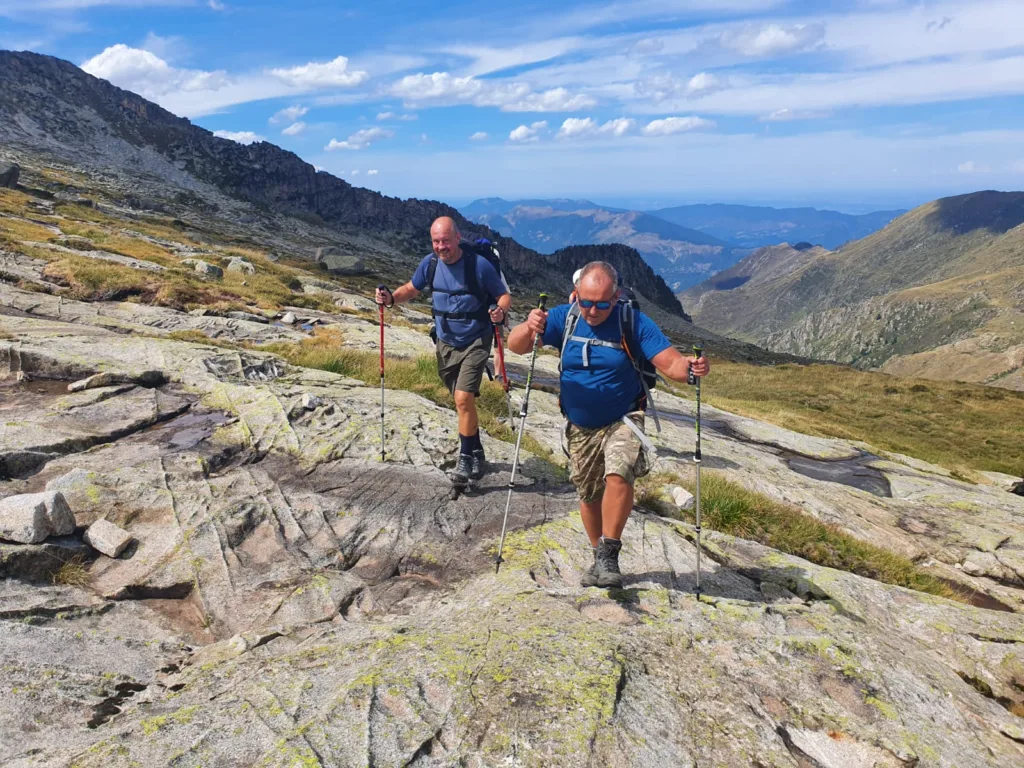
- Pyrenean Haute Route
If the GR10 and GR11 aren’t enough, why not take things a little higher with the Pyrenean Haute Route (PHR)? Widely regarded as one of Europe’s best long-distance hiking routes, it traces a path along the upper reaches of the range, usually between the GR10 and GR11 but occasionally incorporating parts of both. While the aforementioned routes are relatively simple hiking trails, the PHR is a bit of a different beast and involves exposed sections, scrambling, precipitous drops and even areas where ice axes and crampons may be necessary.
As a result, it requires more experience, expertise and confidence than any of the other routes listed above. But, if you are up to the challenge, you will be rewarded with hiking that ranks amongst the best in the world.
Combining hiking and other activities
The Pyrenees are not just for hiking. You can enjoy a whole range of mountain activities alongside your trekking, making it the perfect destination for those who want to mix things up a little. Our The Best Of The Pyrenees – Raft, Trek, Canyon experience is a fantastic demonstration of exactly what is on offer. It includes a 52 km rafting experience in the Catalan Pyrenees, two days on the Thousand Lakes trek and a final day canyoning in the Aigüestortes i Estany de Sant Maurici National Park.
There are also plenty of opportunities for cyclists, skiers and snowshoers. In the summer, the road passes open and world-famous climbs like the Col du Tourmalet become accessible. Many ski resorts also now feature purpose-built bike parks that are popular among mountain bikers when the snows melt. The Andorran resorts are popular with skiers and snowboarders seeking value for money, while Ordesa attracts rock climbers from around the world.
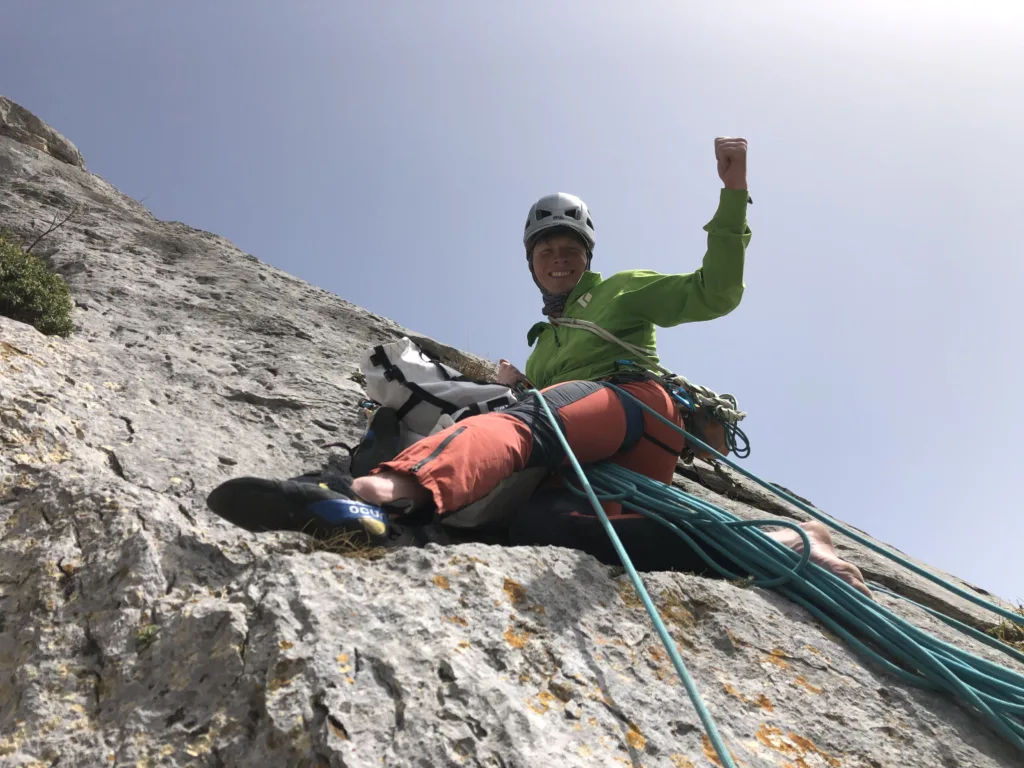
Hiking in the Pyrenees – what you need to know about the climate
For many would-be Pyrenean hikers, the weather is a significant concern. As the range encompasses such a large geographical area and runs from the Atlantic to the Mediterranean, it can be difficult to know when to visit. Generally, temperatures are slightly warmer on the eastern Mediterranean edge of the range, cooler on the western edge and at their coldest in the higher ground at the heart of the range.
The northern side of the mountains (the French side) tends to be more humid, cooler and cloudier, while the southern side (the Spanish side) is drier, sunnier and warmer. June and July are good times to hike as they are usually the driest months. September is also fantastic, as slightly cooler daytime temperatures provide the perfect trekking conditions. However, no matter the time of year, However, this is a mountain environment and you must prepare for changeable weather. Temperatures can drop significantly at night. It is not uncommon for 20℃ daytime highs to fall below zero once the sun sets.
Hiking the Pyrenees with 360 Expeditions
The 360 team adore the Pyrenees and many of us have spent a considerable amount of time exploring and enjoying the region. This is reflected in the number of treks and experiences we offer there. Whether you want to hike the Pyrenees’ greatest hits on our Ordesa & Gavarnie Trek, discover the range’s unparalleled natural beauty on our Thousand Lakes Trek or incorporate some canyoning and rafting into your itinerary by signing up for The Best Of The Pyrenees – Raft, Trek, Canyon experience, we have a Pyrenean adventure for everyone.
To learn more about these trips, check out the relevant tour pages for a full itinerary and answers to our most frequently asked questions. You can also sign up to our newsletter to be first to know about new expeditions. If you have any other enquiries, please don’t hesitate to get in touch with the 360 team.
